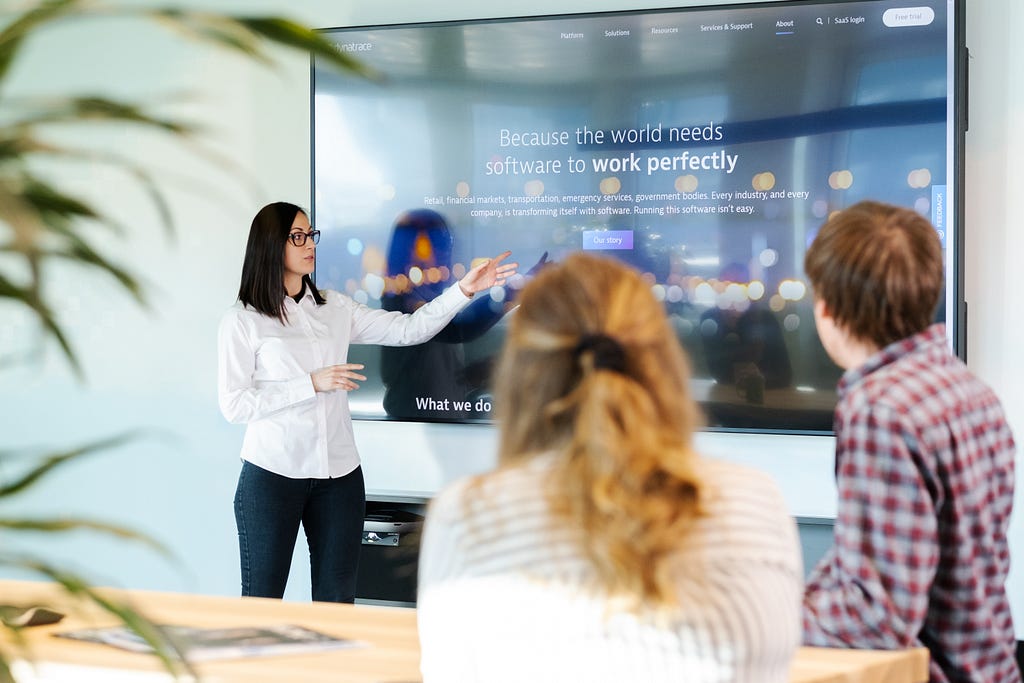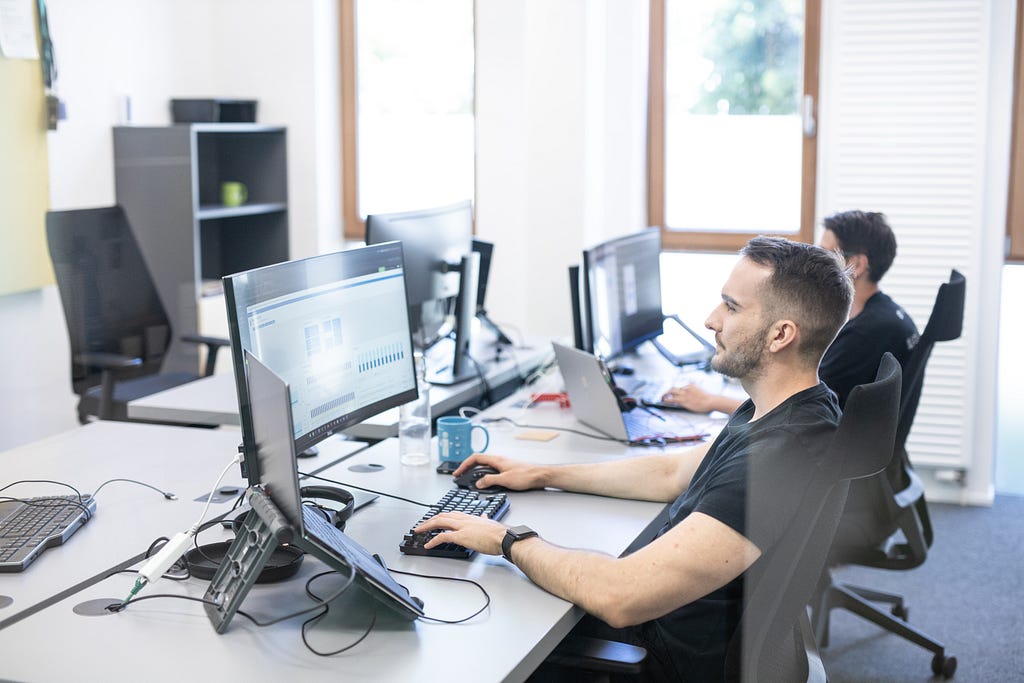What goes into becoming the best IT employer in Austria
A deep dive into which ingredients helped Dynatrace become one of the most celebrated companies in Austria, according to its employees.

Imagine my excitement when after only a couple of weeks of being part of Dynatrace, my new employer was awarded “Best IT Employer in Austria in 2021” by the leading business magazine Trend (criteria explained in the last paragraph). Obviously, I had an inkling that this was a great place to work (or I probably would not have joined the company in the first place), but this gave me the inspiration to learn more about what makes this company so great.
So, I thought I’d take this opportunity to investigate a little bit.
What’s Dynatrace?
Dynatrace is the global market leader in software intelligence with multiple offices around the globe. Although it’s headquartered in Waltham, Massachusetts, most of the Research and Development is done in Europe, where the company was founded. The R&D headquarters are located in Linz, Austria, and in the same country there are also Labs in Graz, Hagenberg, Klagenfurt and Vienna. As many companies had to make the step towards digitalization and started being dependent on software services, they needed to ensure that their software systems were working perfectly at all times. That’s where the Dynatrace platform comes in, which enables companies to monitor their systems at all times. Thanks to this, Dynatrace grew and continues growing, making the big step of being listed on the New York Stock Exchange in 2019.
Around 2,800 people work for Dynatrace worldwide, with approximately 700 employees in Austria alone. To learn why they like working at Dynatrace, I decided to reach out to a selected few individuals from every Lab in Austria, each with different roles and lengths of time in the company, to find out what attracted them to Dynatrace and what made them stay.

Judging by their responses and from what I’ve seen on online review platforms, I can summarize the Dynatrace experience into a few key ingredients:
- Working on an exciting product
- Cutting-edge technologies and agile software development
- Employees are individuals and not numbers
- Awesome team members
- Autonomous decision making
- Training on the job
- Dedication to employee experience
But let’s look into each of these topics into detail and learn more about what each individual values most.
“As soon as I did my on-site interview, I felt the culture and the vibe. It was what convinced me to take the offer in the end. Like, this company is something else, but I can’t quite put my finger on it.”
Catherine Easdon, software engineer at Dynatrace
Working on an exciting product
Matthew Reider, who has been working at Dynatrace in the Linz Lab since September 2019 as a Product Manager, says he is very invested in working on the product because it combines his two passions: observability and container platforms. As one of the original Cloud Foundry team members, he has a vast experience with building container platforms, even before Docker got started. “I like problems and solving them, they almost feel like a game to me. So, finding the answers to questions like “why is this application misbehaving?” it’s a fun thing to do.”
This passion for working on the Dynatrace platform resonated with most of the people I spoke to. Especially since the company lives the motto of “drinking your own champagne”, which means that Dynatrace is also used internally to monitor our internal systems. This enables them to see first-hand how the product can be useful for clients.
As Catherine Easdon puts it, who joined the Graz Lab in December 2020 as a software engineer, “It’s a really exciting product and I think it’s genuinely useful as well. It’s not just corporate talk. We use Dynatrace internally, so I can really see the use-cases. We use it to track the performance of our service and instantly get alerted if we have either network issues or other problems. It makes troubleshooting so much easier.”
Gabriela Salamanca adds: “We are the customer zero. And as we are customer zero, we provide feedback to product managers, owners and tell them what can be improved or what is not working well. We also collaborate with the architects to improve the use of alerting features, fine-tune them or remove them according to our needs.” Gabriela joined the company three years ago in Linz, starting as a DevOps Engineer in the ACE team and was just recently promoted to Team Captain.

Cutting-edge technologies and agile software development
Closely related to the previous point, one crucial aspect that motivates our more technical employees is the fact that they get to work with high-end technologies and that the agile environment turns software development into an artform. “Ever since I’ve worked here, I’ve always worked with the latest and greatest cloud technology.” says Daniela Rabiser, who has been working at Dynatrace in Linz as Product Manager since 2017.
Coming from a banking background where COBOL is the name of the game, Gabriela Salamanca also mentioned that it was very exciting for her to be able to come to Dynatrace and learn all about the newest cloud technologies, continuous improvement, and automation. “I love the experience of being exposed to a lot of technologies. All we do is think about how to improve, how to make it better, how to make it faster.”
But the company does not just choose to use the latest technology for the sake of it. “We usually just pick the best tool for the job” says Zlatan Zaric, Dynatrace software developer in Graz since January 2020, “Although Java is our main programming language, we have some modules programmed in Go, because we thought it was the best way to go. We are not constrained in the sense that you MUST use Java. We constantly do POCs in different technologies to see what’s the best technology fit for what we are going to create.”
As a Product Manager, Daniela Rabiser spends her working days designing value increments, which are improvements on the software based on customer requirements, the needs of the target market and input from product architects and engineering teams. “Right now, I’m working on OpenTelemetry, which means finding out how to best ingest or capture OpenTelemetry data, integrate it into Dynatrace and then leverage this data for analytics and AI”. Daniela needs to understand customer requirements and market demands, that is why a lot of her work time is spent communicating with partners and customers like SAP and AWS. The information she collects is then turned into end-to-end use cases which address Dynatrace customer’s pain points.
Due to system’s requirements, which relies on being live 99.9% of the time, a lot of focus is placed upon the aspect of “getting it right”. We moved from DevOps to NoOps in 2014 allowing us to maintain uptime for well over 1,500 production nodes and 1,900 managed clusters in the high 4-nines (99.99%) while delivering a major release every other week with no 24x7 operations team. This consequently means that “you can’t develop something, throw the problem over the fence and expect somebody else to do the testing, YOU need to do it. YOU need to worry about the quality. YOU need to take ownership of what you build. Make sure that everything is working properly before we give it to the customers.”, as Zlatan Zaric points out.
An aspect that makes the Product Owner and Team Lead for Open-Source projects Armin Ruech proud of working at Dynatrace is that he has the possibility to work on par with other global companies like AWS, Google Cloud, Azure, etc. “I am very involved in the Open Telemetry standard, which is an open-source standard maintained in collaboration with pretty much all the big players, like Microsoft, Amazon, Google, and also most of our competitors. In my team we are working with other open-source projects to hook them up with Dynatrace.”
Open-source software is at the heart of what Dynatrace does. The company was involved in developing multiple standards, like the aforementioned Open Telemetry, but also Keptn, W3C and others. “We are working to make it easy to activate Dynatrace in Kubernetes, so we built an operator using a framework that Red Hat came up with, and it’s all open-source and available on GitHub” adds Matthew Reider.
“We don’t rest on our laurels with the customer base we have. We constantly change and challenge ourselves with new technologies. We are challenged to keep up and keep ahead, because we don’t want to live off of a cash-cow product.”
Armin Ruech, Product Owner and Team Lead

Employees are individuals and not numbers
The overwhelming majority of interviewees spoke about how they feel that Dynatrace sees them as individuals and not just employees. The company culture allows for a great degree of flexibility and a real balance between work and life.
This can be confirmed by the example of two colleagues who recently became parents: Zlatan Zaric was able to postpone his start at Dynatrace for six months to give himself time to spend with his newborn baby. Daniela Rabiser was recently on parental leave and felt very supported by Dynatrace when she decided to come back to work in a part-time model. “Even though I had to reduce my working hours to attend to childcare duties, I have been asked to take over a very important topic for our solution. I am part of a great team and I have an awesome team lead who support me and I’m very happy about this.”
Besides the colleagues working in the HR departments, employer branding, recruiting and people operations, there are even roles like the Team Captain whose goal is to ensure the team members are happy with their job. Alois Muehleder, who started at the company in 2014 and became Team Captain in the Hagenberg Lab two years ago, defines the role as “happiness manager”. He adds “My main goal is that when my team leaves the office in the evening, there should be a smile on everyone’s face.”
Catherine Easdon, as a team member, agrees “everyone is so friendly, and I think most importantly you are not just an employee. Everyone is valued as an individual. And there are a lot of ways that manifests. If there are ever any concerns, people take them seriously, whatever your level in the “hierarchy”.”
As a product manager, Matthew Reider mentions that he likes the flexibility of your role description. He says that in theory, product management is about the what, while engineering is about the how. But he discovered that at Dynatrace everybody is encouraged to cross to the other side. Engineers get involved with the what and he brings his own input into the how. “We are in it together, and there is no dismissal about your role. We both share a product mentality.”

Awesome team culture
When I asked the interviewees why it is that they liked working at Dynatrace, one of the first things they mentioned was the team. “I really like working with the people here. Even though I am motivated by technology, what makes my job meaningful is building things with people.” says Matthew Reider.
Working at Dynatrace is extremely collaborative and one plus point is that the team is very diverse, not only technically but also culturally. “There are a lot of different point of views on the same problem and this diversity helps you with coming up with a more optimal solution than you would have if you stayed in your own borders.” adds Zlatan Zaric.
There’s a constant feeling of belonging to a team. On your first day, you are welcomed with a box of Dynatrace swag and you are even gifted t-shirts for events like Innovation Days. (And people do wear their hoodies at the office and during Zoom calls — I’m wearing mine right now.)
“It’s a highly professional workplace, that comes with the size. We have experts in virtually every area, and everybody is eager to help. There are no frictions within the company or people who say that they don’t have time for you. There is no bureaucracy.” concludes Armin Ruech.

Autonomous decision making
“Sometimes I feel like I am able to move rocks here at Dynatrace”
Veronika Leibetseder, Head of R&D Lab Operations
One of the core concepts you learn about when joining the company is the autonomy principle, which, simply put, states that every person in the company has the right to implement any decision, as long as they drive it and collect consensus upon it.
“I don’t like the term flat hierarchy”, says Armin Ruech, “because it’s an oxymoron. But we do have a type of hierarchy where every voice is heard and people have the autonomy to make their own decisions, to some extent, and to produce their own impact as long as they own what they produced. It’s not a strict top-down chain of commands that everyone follows, but people are treated equally.”
This feeling of individual autonomy is something that you need to get used to when you join, (after 6 weeks at Dynatrace, I’m still not used to it), but it’s surprising what you can achieve very early in your career. Catherine Easdon, for example, says that she could decide to deprecate an internal feature after only a few months in the company. “I just spoke to the relevant people and by consensus we agreed that it makes sense to deprecate it. It’s nice that a new employee is able to speak up and say, “we need to make a change” and you don’t have to go through a huge hierarchy.”
After 5 years in the company, back in 2015, Veronika Leibetseder, now Head of R&D Lab Operations, led a multimillion-dollar project to build the new office building in Linz, inaugurated in 2020. “If you would have told me that 10 years ago, I would have told you that you are crazy. But it was possible. I think it’s because I had the autonomy, I had the trust and people that believed in me that I can handle this project.”

Training on the job
Every employee at Dynatrace is granted access to Udemy and Pluralsight as a benefit and can invest 2 work hours per week on training. Zlatan Zaric, for example, doesn’t want to be limited to backend development so he is taking advantage of this opportunity to learn about frontend development during his worktime. “They didn’t say “no, stick to backend because we need you there”. Instead. they said, “if you want to expand your horizon, go ahead and do it”.”
Armin Ruech also mentions that he started as a part-time employee while he was studying for his master’s degree at the University of Applied Sciences in Hagenberg in Software Engineering. Whilst working in the OneAgent team, he had the opportunity to write his master thesis on what he was working on and that was a big plus for him. “I was able to write my thesis about something I was already deeply involved with at work, so I could really focus on it” to the benefit of both Armin and Dynatrace.
The Dynatrace Innovation Lab also invests many resources in research in the fields of data and cloud technologies, whilst at the same time collaborating with the most renowned universities in Austria, offering scholarships and other opportunities for their students.

Dedication to employee experience
Talking to Veronika Leibetseder, who is at the head of the whole concept of Employee Experience at Dynatrace, I realize that a great part of what makes Dynatrace a great employer is this dedication of every single individual to shaping the culture and vibe of Dynatrace. Besides tracking the mood of the company via tools like Team Echo or simply by reading what is written in online reviews, you can feel this just by coming into the office and seeing how people interact with each other. “It needs to be lived through every phase of the company. Whatever your role or level, we are equals and communicate at eye level, whether you are the CTO, a software engineer or a receptionist at the front desk it does not matter.”
Veronika also mentions that a dedication to Employee Experience has benefits not only because it helps you retain people, but it pays off in the context of customer experience too. “If you have motivated people, they are more likely to go the extra mile to support a red button alert or be there for a customer whenever they need it. Some minor things make a huge difference.”

Having the right ingredients and knowing how to use them
Judging by the results of the latest Stack Overflow development survey, it seems like Dynatrace is hitting all the marks that are important to developers for a great place to work. However, it needs to be said that, just like with baking a cake, it’s not enough to only have the right ingredients. You also need to know how to mix them to get a great dish out of them. Finding this correct balance between ingredients, process and environment is key to baking the cake of your dreams.
Even though we have all the correct ingredients (great product, cool technologies, team spirit, to name some), what is the real key to success is knowing how to use them, given the current economic and social climate. Dynatrace had to learn to adapt to maintain this culture, as Veronika Leibetseder also eloquently said, whilst growing very fast from startup to large company. And this also means that the balance that is working for Dynatrace at the moment may has to change in the future to stay at the top of its game. But this will only work if we keep putting the Dynatrace people at the center of our decisions.
In the meantime, I’m happy to report that the first impression I got when meeting my future employer over Zoom for my first interview was correct. I’m looking forward to more productive years at Dynatrace and sharing more stories from our people on this platform, to give you all a deeper insight into how we work and why we do things in a certain way.
How Dynatrace Austria was awarded and which criteria went into the decision
The yearly awards are organized by a collaboration between trend (Austrian business magazine), Kununu (online review portal for companies) and Statista (statistics portal for market data).
To gather all information, employees were contacted over Xing and asked to fill out an online survey on their employer. More data was also collected via the reviews on Kununu itself and through trend readers. The companies made sure to include the opinions from a wide sociodemographic and diverse range of people. But the key aspect that influenced the final grade was the willingness of the employee to recommend the company as an employer.
Dynatrace Austria was awarded with 8.25 points, which placed the company as the Best IT Employer in Austria, Best Employer in the region of Upper Austria, and 6th Best Employer in Austria overall.
What goes into becoming the best IT employer in Austria was originally published in Dynatrace Engineering on Medium, where people are continuing the conversation by highlighting and responding to this story.
